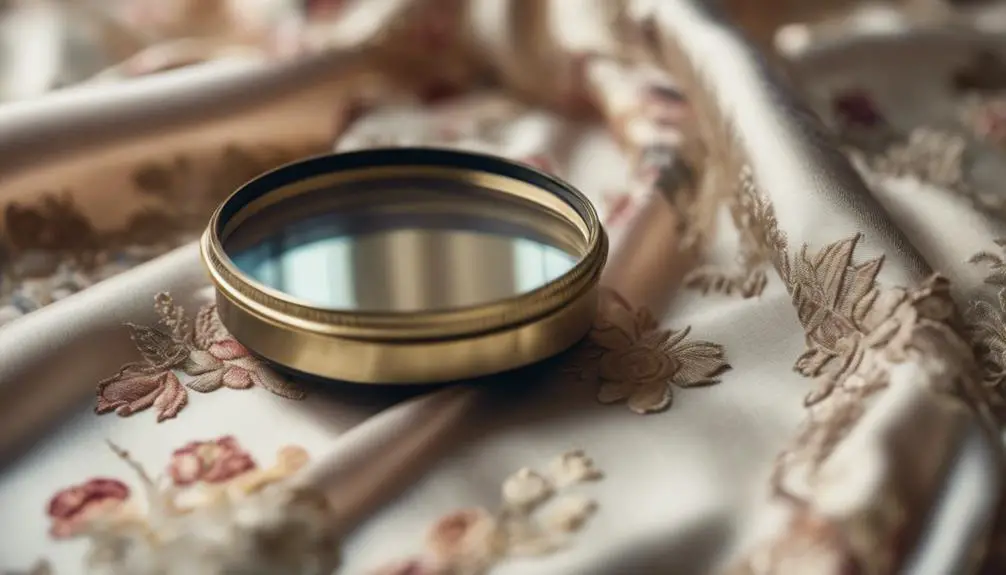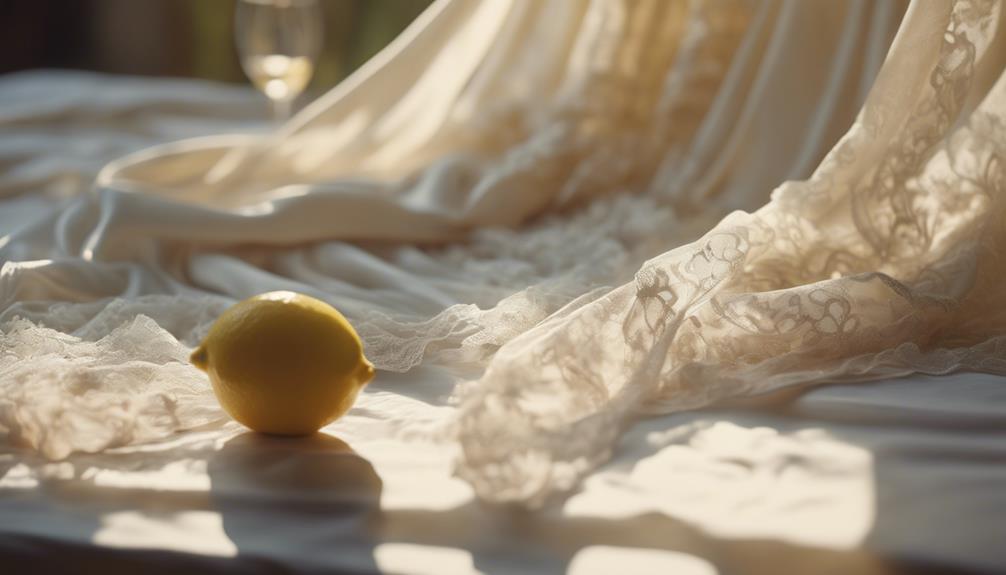To wash a vintage silk dress, start by filling a basin with cool water and adding a gentle detergent for delicates. Submerge the dress, gently agitating it for a few minutes to lift dirt. Rinse with cool running water until the water runs clear. After washing, roll the dress in a clean white towel to remove excess water; never wring it. For stains, blot with cold water and a detergent solution or a mix of lukewarm water and white vinegar. Proper drying and storage techniques can also extend your dress's life; keep exploring these strategies to guarantee its longevity.
Fabric Identification Techniques

Identifying the fabric of your vintage silk dress is vital for proper care and maintenance. Start by employing effective fabric identification techniques to distinguish silk items from synthetic materials. One reliable method is the burn test; silk emits a burning hair smell, while rayon produces a scent resembling burning paper.
Vintage clothing often features unique identifiers that can help with this process, such as labels from well-known designers that indicate fabric types and era.
Next, consider the tactile and visual characteristics of the fabric. Silk typically feels cooler to the touch, while rayon feels warmer and more synthetic. When examining the fabric, remember that chiffon is lighter and more translucent than silk crepe de chine, aiding in accurate identification.
It's important to be cautious with established vintage sellers, as they may misidentify fabric types. Always check for accurate labeling and the specific characteristics of the fabric.
Vintage clothing, particularly nightdresses, may be crafted from materials designed for regular washing, but keep in mind that certain silk varieties require specialized care due to their age and weave.
Hand Washing Process
Once you've accurately identified the fabric of your vintage silk dress, it's time to proceed with the hand washing process to guarantee its care.
Begin by filling a basin with cool water, then add a few drops of gentle detergent specifically designed for delicates to create a cleaning solution. Submerge the vintage silk dress in the water, gently agitating it for a few minutes. This action helps loosen any dirt without twisting or rubbing the delicate fabric.
After washing, it's vital to rinse the dress under cool running water until the rinse water runs clear. This step guarantees all soap is removed, preventing residue buildup that can damage the fabric.
To absorb excess water, carefully roll the dress in a clean white towel, avoiding any wringing, as it can harm the delicate fibers.
Stain Removal Methods

When you notice a stain on your vintage silk dress, acting quickly is crucial to prevent permanent damage. Start by testing for colorfastness; dampen a concealed area of the fabric with a cloth to confirm the dye doesn't bleed. Once confirmed, you can proceed with the appropriate stain removal methods.
- Fresh Stains: Gently blot the stain with a solution of cold water and gentle detergent. Avoid excessive rubbing to protect the delicate wash of the silk clothing.
- Tougher Stains: For more persistent stains, mix 2 cups of lukewarm water with 2 tablespoons of white vinegar or lemon juice. Use a sponge to apply the solution, lightly working it into the fabric.
- Rinse: After treatment, always rinse the affected area under cool running water until the water runs clear to remove any detergent residue.
If you encounter stubborn or set-in stains, consider consulting a professional cleaner who specializes in silk. This guarantees you prevent potential damage from home cleaning methods, maintaining the integrity of your beautiful vintage piece.
Machine Washing Guidelines
Carefully evaluating your vintage silk dress for its machine washability is essential before proceeding with any cleaning. First, check the care label; if it states "dry clean only," avoid machine washing altogether. If it's safe to machine wash, sort your dress with similar colors and fabrics to prevent color bleeding and damage during the wash cycle.
Next, place the silk dress inside a mesh laundry bag. This step minimizes friction and tangling, protecting the delicate fabric from potential damage caused by other garments. Set your washing machine to a delicate cycle, using cool or cold water. This approach reduces the risk of shrinkage while preserving the fabric's luster.
After washing, never tumble dry your vintage silk dress. Instead, hang it to air dry away from direct sunlight, which can cause fading and distort its shape.
Following these meticulous washing guidelines can help maintain the beauty of your vintage silk dress, ensuring it remains a treasured part of your wardrobe for years to come.
Drying and Ironing Tips

After washing your vintage silk dress, it's important to handle it with care to preserve its delicate fabric. Avoid wringing or twisting the silk, as this can cause damage. Instead, gently blot excess water using a white cotton towel.
For the drying process, follow these steps:
- Hang the dress on a padded hanger to drip dry over a bathtub or sink.
- Make certain it's away from direct sunlight to prevent fading.
- Allow the silk to air dry for no longer than one hour; prolonged moisture can weaken the fibers.
When it comes to ironing, always turn the dress inside out. Use a low setting or a silk-specific setting on your iron.
To protect the fabric, place a cloth between the iron and the silk to prevent direct contact and potential scorching. Alternatively, consider steaming the dress rather than ironing. This method is gentler and helps retain the fabric's natural sheen without the risk of heat damage.
Long-Term Care and Storage
To guarantee your vintage silk dress remains in pristine condition over time, proper long-term care and storage are vital. Start by placing your silk dress in breathable fabric garment bags. This step prevents moisture accumulation and protects against pests like moths.
When hanging your dress, always use padded hangers; they maintain the garment's shape and prevent stretching of the delicate fabric.
It's essential to store your silk garments away from direct sunlight, as exposure can lead to fading and fabric deterioration. Regular inspections of your stored silk dresses help you catch any signs of damage, such as staining or wear, allowing for prompt intervention.
Additionally, rotating the positioning of silk items in your closet is advantageous. This practice minimizes wear from constant hanging and promotes even air circulation, further protecting your vintage pieces.
For ideal long-term care, remember that the right storage environment greatly impacts the lifespan of your silk dress. Maintain a cool, dry space to guarantee your cherished garment remains as stunning as the day you acquired it.
Frequently Asked Questions
How Do You Wash Vintage Silk Clothes?
To wash vintage silk clothes, always check care labels first. Conduct a colorfastness test, then hand wash in cool water with gentle detergent. Avoid wringing, and air dry away from sunlight to preserve fabric quality.
Can You Put a Silk Dress in the Washing Machine?
You shouldn't put a silk dress in the washing machine without checking the care label first. If it's machine washable, use a mesh bag, delicate cycle, cold water, and avoid heavy fabrics to protect it.
How to Clean a 100% Silk Dress?
To clean a 100% silk dress, always check the care label. Hand wash gently in cool water with a delicate detergent, rinse thoroughly, and air dry away from sunlight to maintain its luxurious quality.
Can You Hand Wash Silk Dress That Says Dry Clean Only?
You shouldn't hand wash a silk dress labeled "Dry Clean Only." The fabric's delicate nature can be compromised. Always assess its condition first, and consider consulting a professional cleaner for safe maintenance options.





Can you be more specific about the content of your article? After reading it, I still have some doubts. Hope you can help me.
I don’t think the title of your article matches the content lol. Just kidding, mainly because I had some doubts after reading the article.